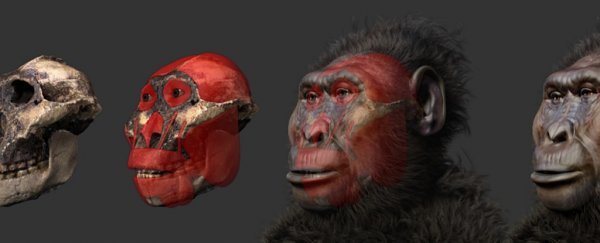Our ancestors have been catching herpes since before we were human. The infection is quite common today; the World Health Organisation estimates that two-thirds of adults under 50 are infected with the herpes virus that causes oral cold sores. One in six have genital herpes.
Yet humans might have dodged herpes' below-the-belt blow if it weren't for an ancient encounter between early members of our genus and a more distant primate relative.
Blame genital herpes on Paranthropus boisei, a heavy-jawed primate with teeth so large it earned the nickname the Nutcracker Man. So say a team of virologists and anthropologists hunting for herpes's ancient origin.
Their statistical detective work, meshing geographic and fossil evidence, was published in the journal Virus Evolution on Sunday.
Herpes viruses are as varied as they are old. There are more than 100 different kinds of herpes. Eight regularly infect humans, causing diseases like chickenpox and mononucleosis.
What we commonly call herpes are two types of incurable herpes simplex viruses, HSV-1 and HSV-2. Oral cold sores are almost always caused by HSV-1. HSV-2 is typically sexually transmitted.
(Spikes in HSV-1 genital infections, attributed to a rise in the popularity of oral sex, have muddied the distinction.)
Our closest living relatives, gorillas and chimpanzees, get herpes simplex infections, too. "Every other species of primate only has one kind of herpes simplex virus," said Charlotte Houldcroft, a virologist at the University of Cambridge in England.
Houldcroft and her colleagues suggest that a long-ago meeting of two primates - when Paranthropus boisei met Homo erectus - explains why our story is different.
Scientists had previously analysed the herpes genome and created a viral family tree. Oral herpes, HSV-1, has been around since humans and chimpanzees split 6 million years ago, as The Washington Post reported in 2014.
The researchers also discovered that HSV-2 must have jumped from ancestral chimpanzees into the human lineage later, as recently as 1.4 million years ago.
Houldcroft and her colleagues used a statistical model, called a Bayesian network, to link primate species through possible lines of transmission.
The authors collected half a dozen possible culprits from 30 prehistoric species. The ancient patient zero had to share paleontological time and geographic space with a human ancestor.
"It was almost like a murder mystery: Who had motive and opportunity? Who was in the right place at the right time?" Houldcroft said.
In the model's most likely scenario, Paranthropus boisei infected a human ancestor called Homo erectus.
"They're writing the history," said Joel Wertheim, an evolutionary biologist who studies infectious disease at University of California, San Diego's medical school.
Wertheim, part of the team who conducted the 2014 herpes genomic analysis, was not involved with this new research. He called the recent study a "detailed, textured history of the geography of these ancestral species."
The event must have involved swapping bodily fluids. "You can speculate in any scurrilous way that you like because we can't be sure," Houldcroft said. But she said she believes violence was the answer.
Perhaps our ancestor killed and ate a Paranthropus boisei. Perhaps Homo erectus scavenged on Paranthropus boisei's corpse. Perhaps the Nutcracker Man chomped on an attacking Homo erectus in defense.
"The idea that it possibly would have jumped over during a violent encounter, butchering and eating, is actually very similar to the way modern chimp viruses have jumped into humans," Wertheim said.
People who butchered chimpanzee carcasses, he said, were the first exposed to the pandemic strain of HIV.
Rick Potts, a paleoanthropologist with the Smithsonian's Human Origins Program, said that this scenario was possible. The evidence is good that the species overlapped 2 million and 1.5 million years ago, he said.
Archaeologists have found Paranthropus boisei fossils in the same landscape as tools made by Homo erectus.
But Potts said wasn't completely convinced that Homo erectus had to catch HSV-2 from a hominin like Paranthropus.
"It strikes me that if Paranthropus boisei could have obtained a virus from ancestral chimpanzee, why couldn't Homo erectus have done so?" he said.
There are other questions this work cannot answer, such as why HSV-2, if it incubated in Paranthropus boisei before migrating to the genus Homo, prefers genital tissues. "That's something virologists are still doing work to answer," Houldcroft said.
Primate viruses continue to evolve. "Viruses are constantly going to be jumping from other species into humans, especially from other apes," Wertheim said.
"Understanding where these ancient pathogens came from and how they got into humans can help us understand where our future pandemics will likely arise."
2017 © The Washington Post
This article was originally published by The Washington Post.
